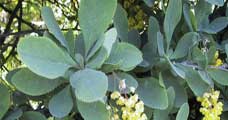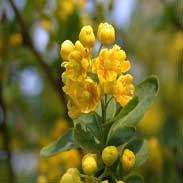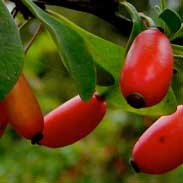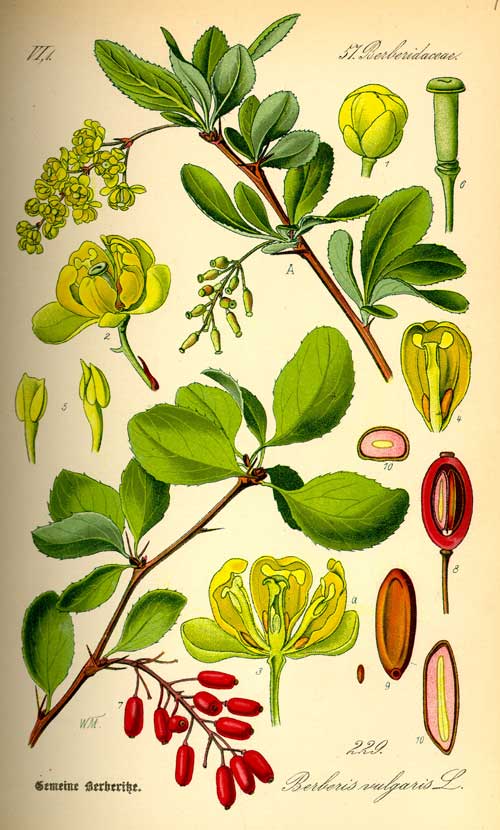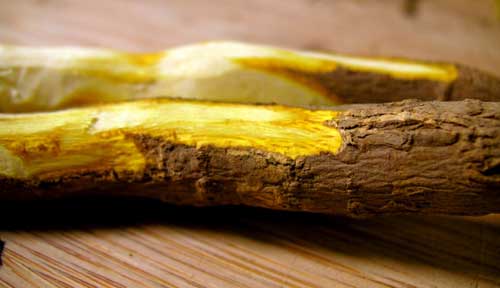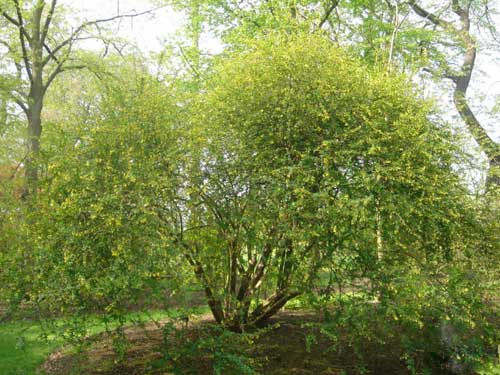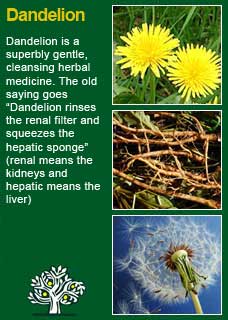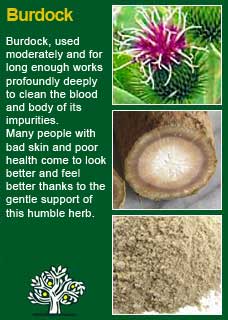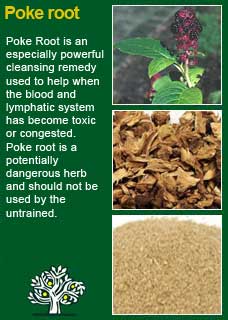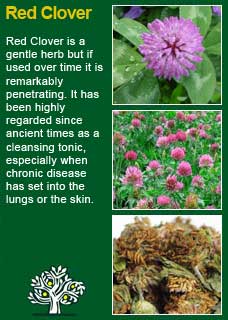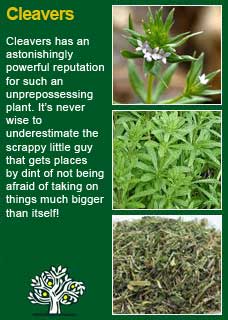
|
|
||||
| Our Pages ABOUT CONSTITUTIONAL MEDICINE
|
Barberry is a thorny, yellow-wooded and long-lived shrub with arched, hanging pale-green leaves, small yellow flowers and red, oblong berries. The main part used in herbal medicine is the outer bark of the roots.
Barberry has a rich historical use, including the Ancient Egyptians using it against the plague; medieval monks using the berries as food and the root as a medicine for all kinds of sicknesses and Polish leather crafters making a beautiful yellow dye from the wood. In addition to using Barberry for liver and gall-bladder problems, traditional Russian healers recommended it for inflammations, high blood pressure and abnormal uterine bleeding Avicenna, in his Canon of Medicine - one of the most influential medical books in history, writes of Barberry being markedly cooling and drying. He says 'It is very strong for eradicating the yellow bile and for swellings and pimples: It strengthens the stomach and liver and quenches the thirst.' H Felter writes 'Barberry acts much like Hydrastis (Golden Seal) and could be employed for many of the uses of that scarce and high-priced drug so far as the berberine effects are required. The fluid preparations are asserted to act more kindly and more efficiently than berberine itself. It was very early used in domestic medicine for sore eyes, and later by practitioners for chronic catarrhal ophthalmias. It is decidedly tonic and if pushed, purgative. Used short of its cathartic action it is of value in non-obstructive jaundice and in gastric and intestinal dyspepsia. In renal catarrh, occasioned by the presence of calculi, small doses may be given when there is burning and soreness and excess of mucus in the urinary tract' WM Cook writes '...the bark is intensely bitter, rather stimulating and slightly relaxing. Its action is principally that of a tonic, improving the appetite and strength in debilitated conditions, and especially in bilious affections, it exerts a distinct impression on the gall-ducts, favoring the escape of bile, always proving gently laxative, and even acting as a mild and slow cathartic in large doses' TJ Lyle writes 'in small doses it is a valuable tonic in convalescence, and is of especial value in bilious attacks. The bark and leaves are intensely bitter, and form a good stimulating tonic hepatic and alterative, influencing the mucous membranes, the kidneys, liver and spleen. This remedy improves the appetite, digestion and assimilation, and is especially useful in debilitated conditions. It is mildly laxative to the bowels as well as hepatic and hence is valuable in jaundice. It may be added to other alteratives with excellent results' From King's Dispensatory (1898) 'A tea made from the bark of Barberry is taken during the spring months as a blood purifier. A strong decoction is employed as an application to the sores which sometimes afflict children's lips, and in certain conditions of the system demanding tonic treatment; the infusion is a favorite remedy. It is more satisfactory in its action than the alkaloid berberine. The bark is bitter and astringent, and has been used with advantage as a tonic. A decoction of the bark or berries, has been found of service as a wash in aphthous sore mouth, and in chronic ophthalmia. Webster declares it of value in jaundice when there is no obstruction of the bile ducts, and in doses short of purgative stimulates the duodenal functions relieving intestinal dyspepsia. Small doses are also palliative in renal calculi, and in soreness, burning, and other unpleasant sensations of the urinary tract.' Thomas Bartram recommends Barberry for toxaemia from drugs and environmental chemicals and gives a list of recommendations for its use including 'a sluggish liver, jaundice, biliousness, gastritis & gallstones.' Maude Grieves says '...it is used in all cases of jaundice, general debility and biliousness, and for diarrhoea.' She says that 'as a bitter stomachic tonic, it proves an excellent remedy for dyspepsia and functional derangement of the liver, regulating the digestive powers.' Simon Mills says Barberry is for 'debilitated conditions marked by poor digestive function and a history of dietary or alcohol abuse, or excessive exposure to drugs, chemicals or industrial pollutants.' Barberry extract is used to treat conjunctivitis in Germany where they use a preparation called Opthiole. This is consistent with an old treatment using Barberry tea as a compress for sore, infected or inflamed eyes. John Heinermann talks about Barberry in his book on Healing herbs 'Ros Nez of Teesto, Arizona is one of a dwindling number of Navajo 'singers' or shamans. For years he has used medicinal herbs to cure diseases in hundreds of Navajo patients. One of his favourite remedies is Barberry root bark for fevers of all kinds. Ross digs around the base of a Barberry shrub, uses his pocket knife to cut away a few of the roots, but leaves the rest so the bush won't die. He then scrapes away slivers of the outside bark until there is the equivalent of one-half palm full. This he throws into an old coffee-pot filled with about 1-1/2 pints of water (approx. a litre) and lets the mixture percolate on low heat for about 20 minutes. Then he strains the tea and gives one cupful to a patient stricken with fever. He repeats this every four hours and makes sure it is taken on an empty stomach. He swears it has never failed to work for him in all the years he has been practicing as a medicine man.' Nez also told Heinermann that 'the same tea he used for curing fevers was also effective for promoting bowel movement in cases of constipation, in clearing up alcoholic hangovers, and in returning the blood to normal in those with a history of hepatitis; half-cup doses every 6-8 hours was what he recommended.'
~ The berberine in Barberry has remarkable infection fighting properties and studies from different parts of the world (e.g. Amin AH, Subbaiah T, Abbasi Km. Can J Microbiol 1969;15:1067-1076, Palasuntheram C, Sangara Iyer J, De Silva LB et al. Ind J Med Res 1982; 76 (suppl):71-76) show that it kills microorganisms that: ~ Barberry can help improve some key aspects of the metabolic syndrome. One study comprised type 2 diabetic patients (N=57). They were randomly assigned into three treatment groups: processed B. vulgaris (N=19), apple vinegar (N=19), and control (N=19). The outcome measures of height, weight, serum total cholesterol, HDL and LDL cholesterol, triglycerides, glucose, and insulin levels were analyzed at baseline and after eight weeks. BMI, the total:HDL cholesterol ratio, and insulin resistance were estimated. B. vulgaris treatment resulted in a significant reduction in LDL cholesterol concentration (22.48 ± 35.44mg/dL) and the total:HDL cholesterol ratio (2.56 ± 4.87) and a significant increase in HDL cholesterol concentration (12.33 ± 20.58mg/dL) (p<0.05) (Ebrahimi-Mamaghani M, Arefhosseini SR, Golzar, M, Aliasgarzadeh A, and Vahed-Jabbary M. [Long-term effects of processed berberis vulgaris on some metabolic syndrome components]. Canadian Journal of Forest Research 2009;39(11):2109-2118) The alkaloid berberine in Barberry has been shown to stimulate the immune system by activating the macrophages that devour harmful microorganisms. Most herbalists, including me, feel that you get a deeper, and safer, benefit from the plant by using the whole extract rather than one part of it however it is that same berberine that most of the scientific articles, studies etc. have been made on and a reader with an interest in more of the science on Barberry will find a great deal of literature related to berberine. In any case, it is reported that there is 6.1% of Berberine in the root bark of Barberry so it is certainly possible to get a high dose of it through using the whole plant extract. (Supek Z and Tomic D. Farmakološko-kemijsko istrazivanje zutike (Berberis vulgaris L.). Lijecnicki Vjesnik 1946;68:16) ~ The authors, titles and the 'where-and-when' published of nearly 200 further studies and articles on Barberry are listed in a PDF found here
If you do feel a bit rough, especially in the beginning of a treatment course with Barberry this is not a reason to avoid the herb but it will be important to know that in such cases what you feel is what you get. In other words, there are no further damaging effects that you aren't seeing that you should expect to have to deal with later! Barberry is a potent cleansing herb but surely, when needed, it is better to go through some temporary discomfort of some detoxification to regain your health.
For some years now, against this proven and safe way of herbalism, there has been a rising tide of excessive caution and scare-mongering in many parts of the world. The same authorities that, not so long ago, decried herbal medicines as ineffectual, have now taken up a different adversarial position; that they are dangerous substances that should only be prescribed by Doctors, who of course have zero training in them. Unfortunately, the same unnecessary fear and worry has crept into many natural health websites and popular publications on herbs. Herbs that we have safely used for thousands of years, that have no reports of adverse reactions in the medical literature despite widespread use by millions of people, are suddenly described as contraindicated because of something that should have been seen as completely unimportant, or at the utmost a merely theoretical concern, such as a laboratory study on one of the herb's constituents to use an all too common example. I wonder sometimes if the writers of such articles feel that the herb will be more deserving of respect if it is thought to be a little bit dangerous, in other words more like a drug than something that has simply come out of the earth and been used by ordinary people for generations beyond count. There is just so much misinformation about herbal medicine on the internet now. Ludicrous claims and cautions abound in equal measure; it seems like one group are trying to make money out of the public whilst the other are busily trying to scare them off. I have to believe that the kind of reader who takes the time to read pages on herbs that are as extensive as this one is much less likely to be swayed by marketers or misinformers. I hope that you will keep your wits about you if you get conflicting opinions from people who have never really got to know these herbs, who have never worked with them, or learned how to use them safely and effectively. I want to remind you that the reason that herbs can never be patented and owned by any individual or corporation is because they are, and always will be, the People's medicine. They belong to all of us and it is my great hope in sharing this work that you will learn how to use them wisely for yourself, and the people you care for. Be safe, but do not be afraid.
A person who has not been able to pull themselves out of a chronic illness because they are encumbered, congested, bogged down by tiredness and toxicity, can be the ones who benefit the most from such a medicine as Barberry, because it is a superb liver tonic. I tell my patients 'the liver is the herbalist's favourite organ'. It's something my first teacher, Dennis Stewart, used to say and it's stuck with me. We like to treat the liver because it does the person so much good and, even when they have no idea that their liver is in any kind of trouble, a person usually feels a great deal of positive difference in their health when you use those herbs that activate and cleanse this powerhouse of an organ. The liver is the hottest organ in the body because it works the hardest. 24 hours a day, and especially at night, it is constantly cleaning the blood and at the same time making literally thousands of different, essential chemical compounds that the body needs to repair its wear and tear. Barberry is one of the best, strongest, and most reliable of all liver tonics. I have used it thousands of times and have developed a deep trust that it will activate and cleanse the liver when needed. As is so often the case in herbal medicine the art of a truly successful treatment lies in the dose and in the case of Barberry we have much less wriggle room to get it wrong than many of the other liver herbs. Too much and the person goes too strongly into a period of cleansing that can be more than their system is ready to handle, too low and the job doesn't get done. Bearing in mind that these are the amounts that we use from making our own Barberry tincture from raw material in our clinic the dosages I have typically found to be strong enough but not too strong are in the order of about 2-3 mls. a day, usually in 2 or 3 divided doses. That said, I will gladly use a decoction of Barberry in high doses (5 grams or even up to 10 grams) when someone is acutely unwell and I need to get an immediate and potent effect. Barberry is a herb that can get easier to handle when it has been in the system for a few days and there can be wisdom and safety in building the dose up gradually if you are unsure or if the person taking it knows that they are highly sensitive to cleansing medicines. If you are studying herbal medicine or would simply like to get to know these great plant allies at a more personal level then I urge you to take at least a few drops of Barberry, maybe more if you feel you are up for it, just by itself and at least 2 or 3 times over as many days, to experience the 'action' of the herb for yourself. This is a large part of how we have learned about these remedies since ancient times, how they can be 'felt' and so therefore better understood in this extraordinarily intelligent, living laboratory that we all own; our 'body'. Speaking for myself, when I take a small dose with a quiet and attentive mind, I can almost immediately feel the power of Barberry moving any stuck dampness within. It clears the way like a worker determined to brook no opposition! Barberry has a marvellous presence when you open up to it in such ways that will forever give you a healthy respect for its ability to activate and cleanse your body. I should note that if you do have some physical or even emotional 'stuck dampness' in your body in general or your liver in particular then you will probably get to experience for yourself, in a very practical way, what all this cleansing business is about - but you can be sure it will only do you good in the long run! Further to this, if you would like to learn more about the ancient art of pulse testing, a simple but powerful way to ask the intuitive intelligence of the body for its responses to a herb by feeling the pulse whilst giving a tiny dose by mouth, read here Barberry combines perfectly with Dandelion root and Burdock for deep blood cleansing programs and with Licorice root to cleanse and tone the bowel. If I want to make a liver program about as strong as it can be then I will use the Barberry root along with some Celandine and even possibly a very little Poke Root. Barberry taken along with Red Clover and Cleavers is remarkably good at cleansing the lymphatic system (problems there showing with such things as swollen glands, eruptive skin, or sore joints)
To make 210 mls, which will easily fit into a 200mls amber pharm round. This is just one example of a formula that would give a particularly strong dose of Barberry, along with two other potent liver herbs, Dandelion and Celandine. The Fennel and Ginger are there to improve absorption and, to some extent, the taste! Bearing in mind that these would be tinctures that we make in our clinic, therefore herbal extracts from other companies or practitioners might have a different range, the dose range I would give of a formula like this one, for a sure activation of the liver and general cleanse of the body, would be around 4-6mls twice a day. The treatment would therefore take between 3 and 4 weeks to complete and the person would be most wise to follow a cleansing diet whilst they took the herbs, as written up here
Much of the information here about the traditional uses of Barberry is consistent with the model of thinking whereby one may treat problem A with herb B. There is value in this approach in how it helps us pass on useful knowledge to one another but where it falls short is that people are not all cut from the same cloth! Barberry might work brilliantly for one person but less well for another with the same sort of symptoms -- why is this? Part of the reason is that people vary in their constitutions as to whether they are either hotter or cooler and, at the same time, either dryer or damper. This useful and rather fascinating subject is introduced further here Another big part of using the right herb when it is most needed comes from understanding the need to treat what is going wrong for the person that had led up to their getting a health condition. In this light, Barberry can particularly offer its benefits when a cleansing action is needed in the 'cycle of healing' - more about this here
Please understand that I cannot advise you, including on products or dosage, without seeing you in person in my clinic but for ideas
on how you might find a good herbalist in your area read here |
|
|
© 2011 R.J.Whelan Ltd
